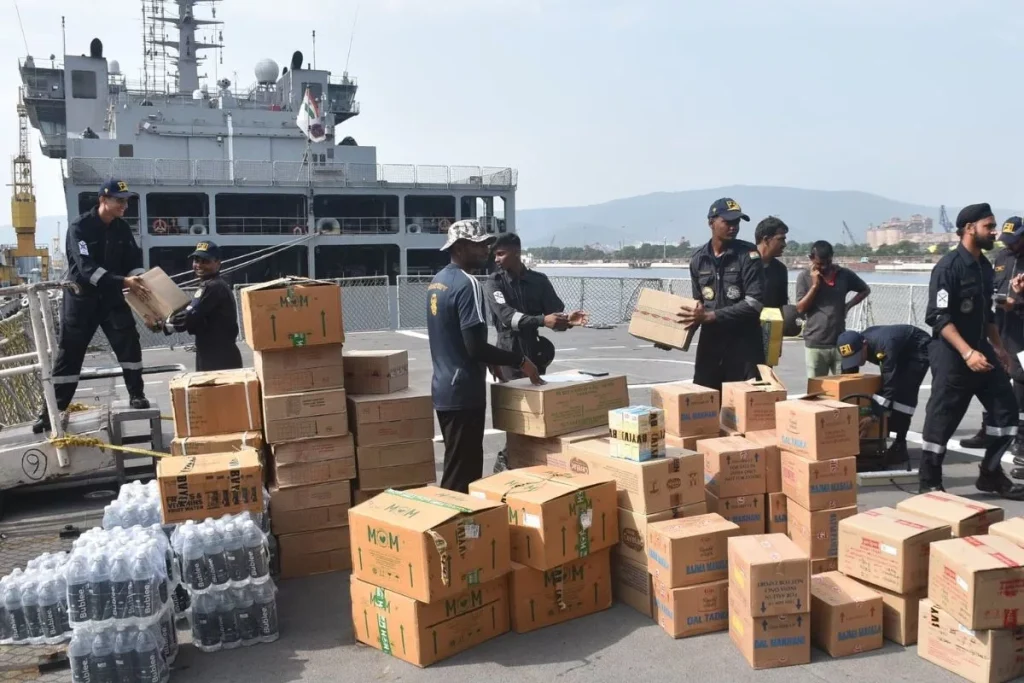Context:
India launched Operation Sadbhav to provide humanitarian assistance and disaster relief (HADR) to Laos, Myanmar and Vietnam in the aftermath of Typhoon Yagi.
More on the news
- The Ministry of External Affairs (MEA) announced $1mn worth of flood relief assistance to Vietnam and $1,00,000 worth of assistance to Laos.
- On September 15, ten tonnes of aid, including dry rations, clothing, and medicines, were sent to Myanmar aboard INS Satpura.
- The Indian Air Force delivered 35 tonnes of aid to Vietnam, consisting of water purification equipment, water containers, blankets, kitchen utensils, and solar lanterns.
- Additionally, ten tonnes of aid, including a generator set, water purification supplies, hygiene items, mosquito nets, blankets, and sleeping bags, have been dispatched to Laos.
About Typhoon Yagi
- Typhoon Yagi formed as a tropical storm in the western Philippine Sea on September 1 and made landfall in the Philippines the next day.
- It intensified over the unusually warm South China Sea, becoming a Category 5 typhoon with peak winds of 260 km/h by September 5. It is one of only four such (Category 5) storms recorded in the region.
- It is the strongest tropical cyclone Asia has seen this year and the second most powerful storm in the world so far this year after Hurricane Beryl.
- Hurricane Beryl, the earliest hurricane to reach category five intensity this year originated in the Atlantic Ocean
- It was named Yagi by the Japan Meteorological Agency (JMA).
Classification:
- The weakest tropical cyclones are referred to as tropical depressions. When a tropical depression strengthens and its maximum sustained winds reach 39 miles per hour (63 km/h), it becomes a tropical storm, according to the National Oceanic and Atmospheric Administration (NOAA).
- Storm systems with sustained wind speeds of 119 km/h or higher are classified as hurricanes, typhoons, or tropical cyclones, depending on their geographic location.
- The intensity of a tropical cyclone is categorized by its sustained wind speed, using the Saffir-Simpson Hurricane Wind Scale. It classifies storms into five categories, from Category 1 to Category 5.
- Category 1 cyclones have winds ranging from 119 to 153 km/h, while Category 5 cyclones, the most powerful, have wind speeds of 252 km/h or greater.
- Tropical cyclones that reach Category 3 or above are classified as major tropical cyclones due to their potential to cause severe damage.
Significance of the Operation
- First Responder: India has consistently been among the first nations to respond to humanitarian crises in the region, demonstrating its proactive approach to HADR.
- Operation Sadbhav: This operation is part of India’s broader initiative to contribute to HADR efforts within the ASEAN region, showcasing India’s commitment to regional stability and support during emergencies.
- Act East Policy: India’s involvement in HADR, including Operation Sadbhav, aligns with its longstanding ‘Act East Policy,’ which aims to strengthen ties and cooperation with Southeast Asian nations.
About Tropical cyclones
- They are low-pressure systems that form over warm tropical waters. They typically form when the following conditions occur:
- High sea temperatures of at least 27°C.
- Converging winds near the ocean surface forcing air to rise and form storm clouds.
- Winds that do not vary greatly with height – known as low wind shear. This allows the storm clouds to rise vertically to high levels.
- Sufficient distance from the equator for a spin such as the Coriolis force to take effect.
Also Read:
Road Connectivity Project for Left Wing Extremism Affected Areas (RCPLWEA)

